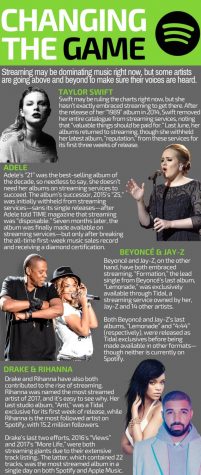Streaming: Is it dominating or destroying the music industry?
Gone are the days of the iPod, CD player and vinyl. There’s a new format controlling how we listen to music—streaming.
The numbers don’t lie
In recent years, streaming services like Spotify, Apple Music, Tidal and even YouTube have allowed music listeners easier access to the songs they love. Thanks to the rise of the smartphone, there is little need for CDs or digital downloads.
According to NME, streaming accounted for 51 percent of the music industry’s revenue in 2016, a 60.4 percent increase from 2015. Sales in digital downloads and physical CDs, on the other hand, were down 22 and 16 percent, respectively.
These aren’t the only declining numbers. With the rapid decline in purchased music, the worth of the industry itself could plummet from $3.9 billion (as of 2012) to $600 million by 2019, a $3.3 billion loss, according to The Guardian.
Despite this, most artists have embraced streaming as a way of ensuring continued commercial success and relevance. Jay-Z and Beyoncé have depended on the exclusivity of services like Tidal, which they both co-own with 14 other artists, for their most recent releases.
Of course, these artists’ reliance on streaming for exclusive releases forces consumers to either give in to it or wait for the physical and digital download versions.
Resisting the norm
That’s not to say CDs and digital downloads have completely died out. A select few artists have challenged streaming, making up for some of the revenue lost by the popularity of services like Spotify. Adele famously withheld her last album, “25,” from streaming services for seven months—while also selling 3.38 million copies in its first week, the highest first week sales record in music history.
Taylor Swift similarly, and rather controversially, removed all of her music from streaming services in 2014, noting that “valuable things should be paid for.” She stood by this until last June, when she mysteriously added all of her music back to streaming services—though probably not by choice.
“For the artists, there really isn’t a financial incentive,” OU music professor Ben Fuhrman said.
Why, then, are artists subjecting themselves to the potential economic losses that are so closely tied with streaming? It’s simple—relevance.
“I think withholding [music from streaming services] is just going to make you irrelevant,” OU communication professor Rebekah Farrugia said. “Unless you’re Taylor Swift, but even she did it.”
Furhman agreed, citing it as “a necessity in order to build a fanbase” and arguing that there are other sources of income for artists.
“It helps build buzz and promote concerts, which, when combined with merch sales, is where more and more independent artists are making the majority of their money,” he said.
However they feel, though, artists need to get used to it. Streaming is now even being taken into account for music charts. Billboard increased the role of paid subscription streams in a song’s chart placement earlier this year. While sensible given the drastic shift to streaming music, the decision also isolates the small percentage of consumers that have yet to adapt to the change.

Looking forward
So, what does this mean for the future of the industry?
Streaming isn’t going anywhere, so the only thing artists and consumers can do is adapt. It’s an inevitable comparison, but the music industry is following in the path of journalism—an excess of free content has led to a lack of revenue. Perhaps more streaming services should enforce paid subscriptions. Among Spotify, Apple Music, Tidal, Amazon Music and Google Play Music, subscriptions are usually no more than $10 a month, and for avid music consumers, it’s a small fee. Rather than paying for individual music every time a new song or album drops, consumers can pay $10 and have unlimited music access. For artists, this won’t change much, as album sales make up a small percentage of their profits anyway.
“People like Chuck D from Public Enemy were going on tour across college campuses 15 years ago talking about how little money artists got from album sales, too—like, you get $1 per album,” Farrugia said. “You’re just indebted to the industry forever.”
This doesn’t mean digital downloads and CDs necessarily have to go away either. As Adele and Swift have proven, some artists can still be successful without streaming—however, with its rise, the longer they distance themselves from it, the more fans they risk losing.
No one has found a foolproof method to resolve the rapidly declining sales of the music industry yet. Its future remains unclear—streaming could ultimately lead to the demise of CDs and digital downloads, or it could join their ranks when the next form of music consumption inevitably arrives.
Until then, the industry will continue to change how we listen to music, and we will continue to adapt—though who can say if it’s for better or for worse?






